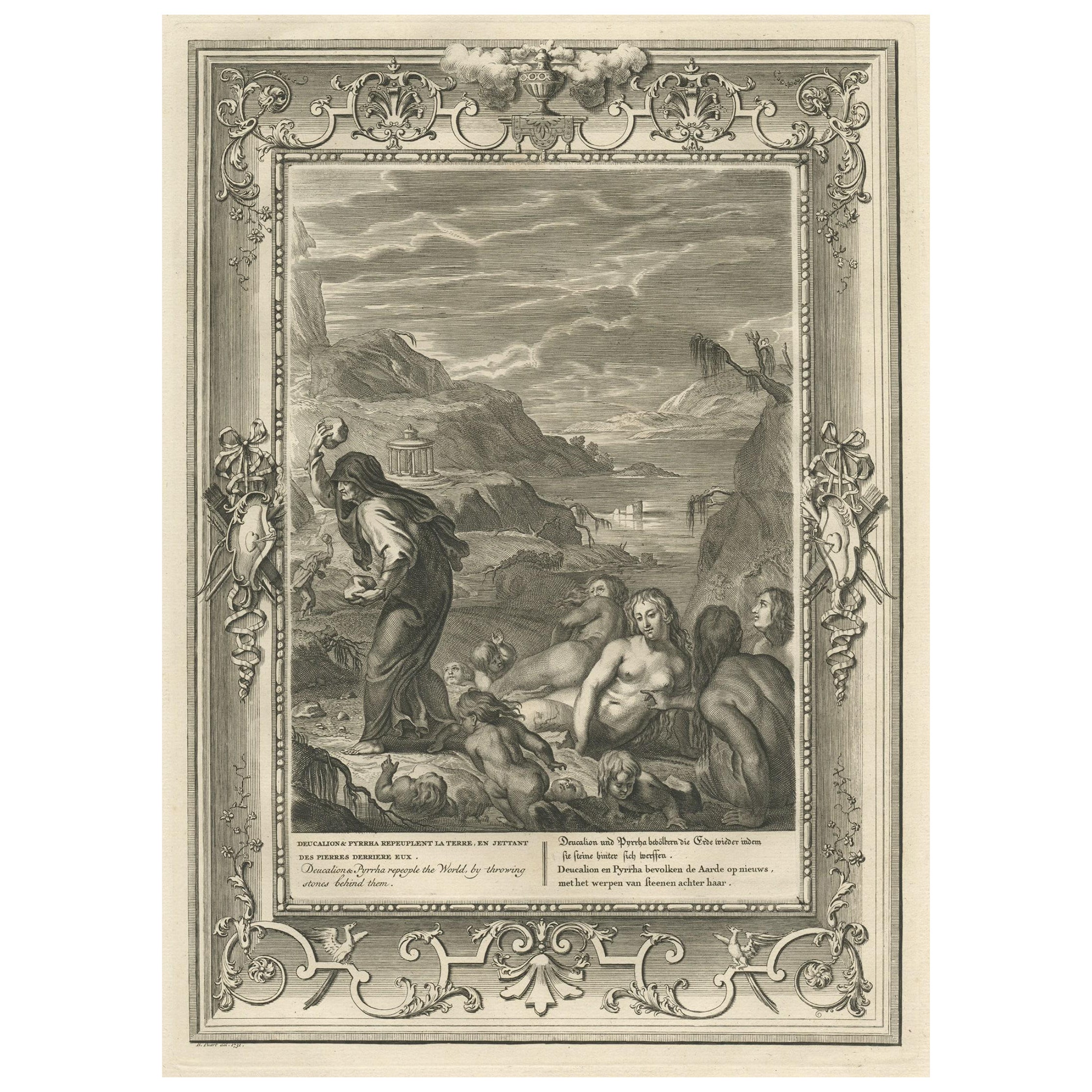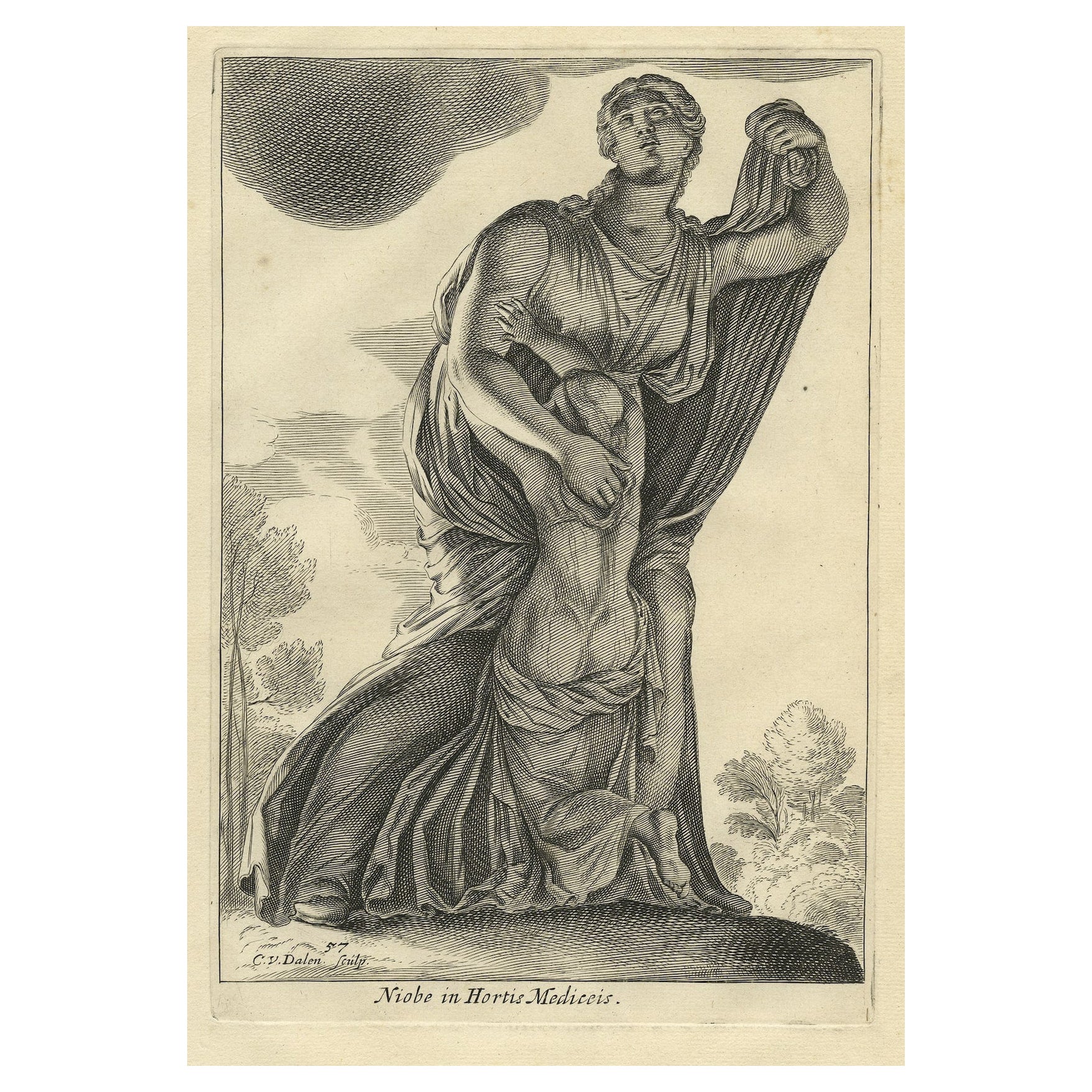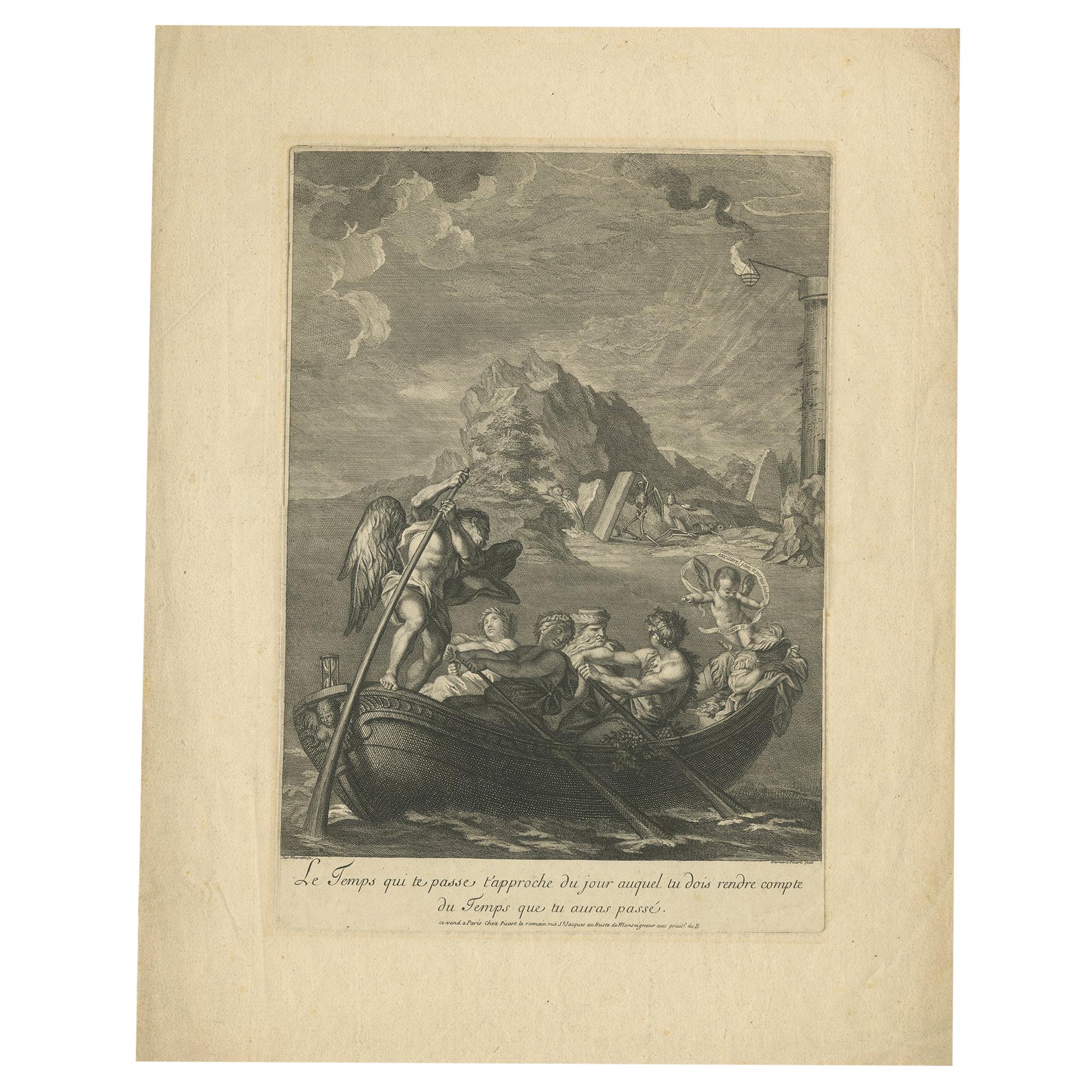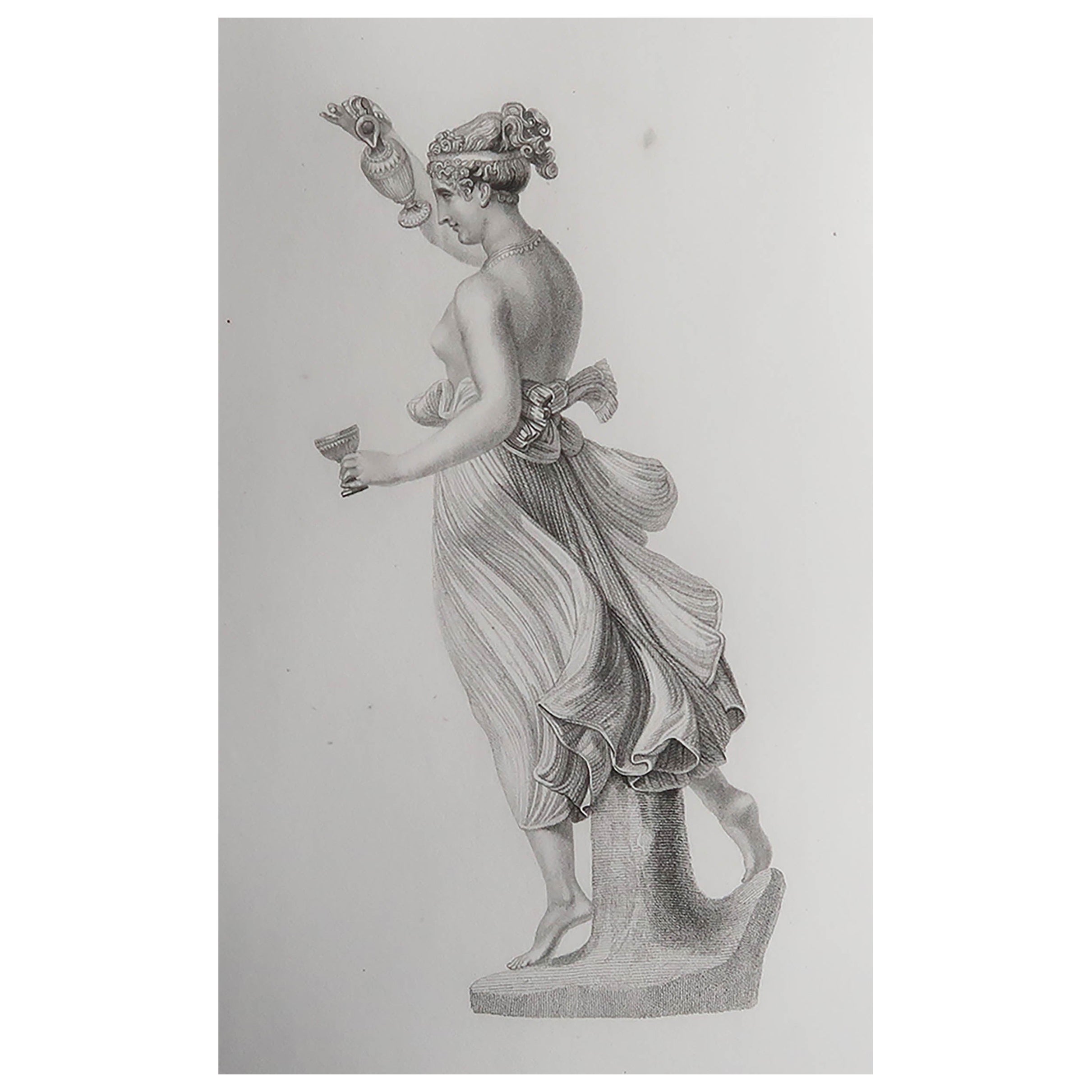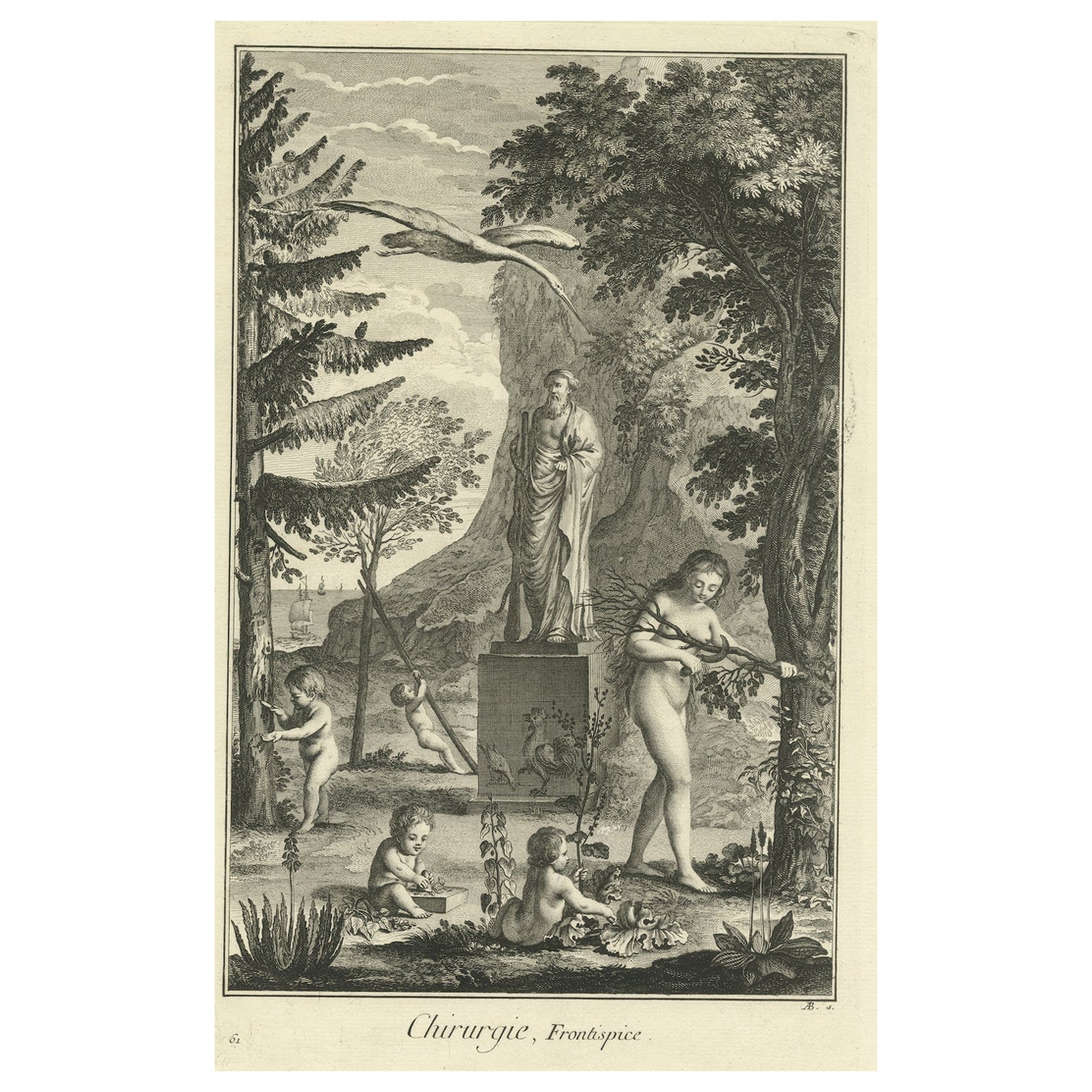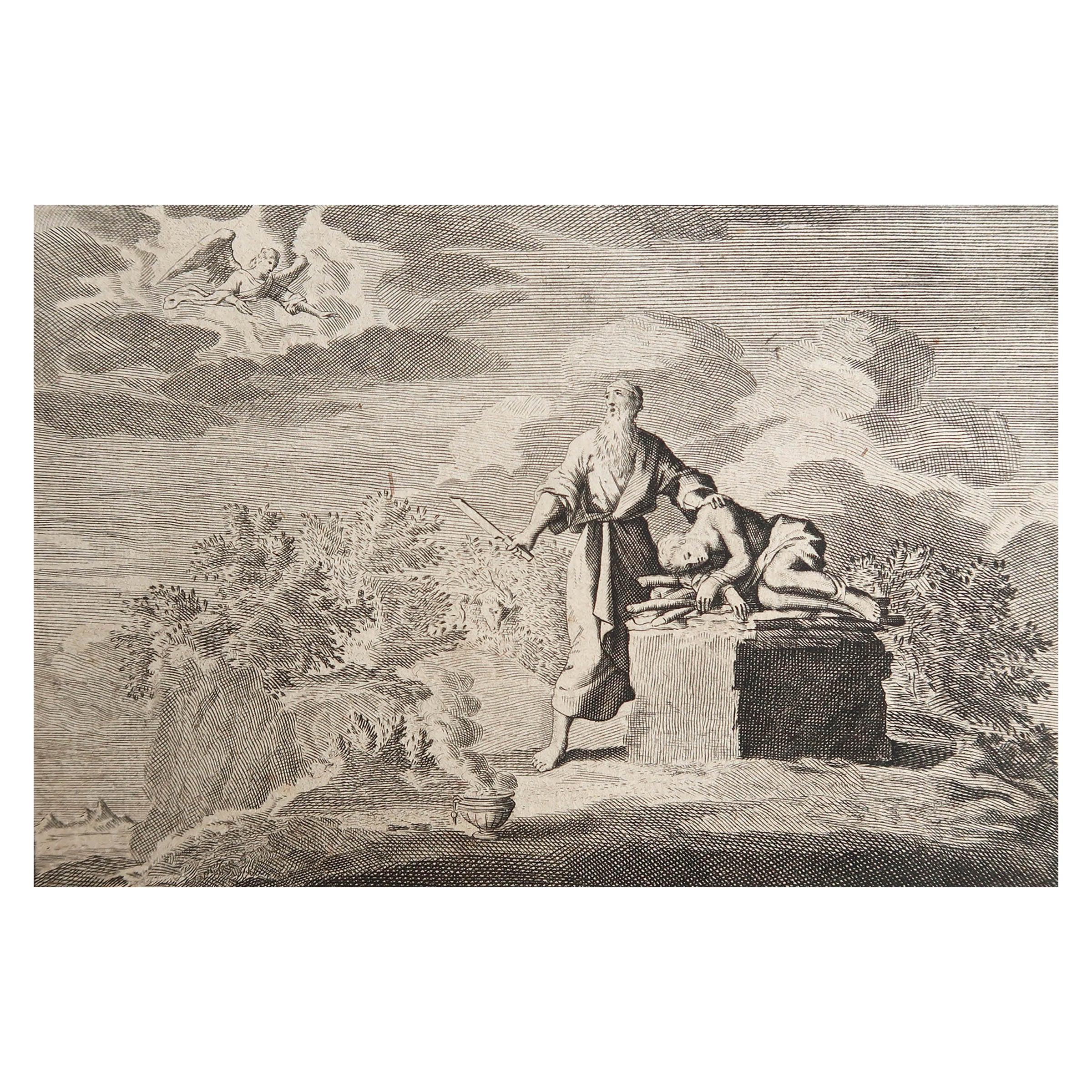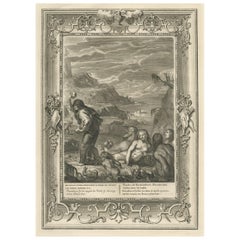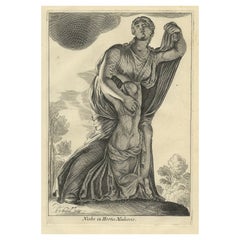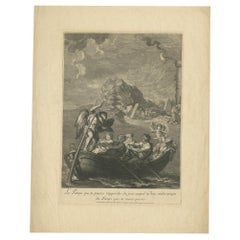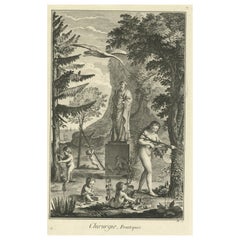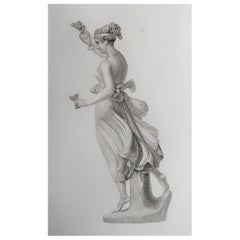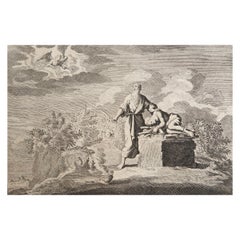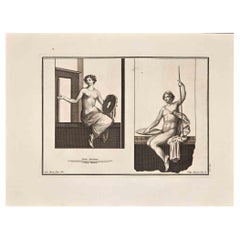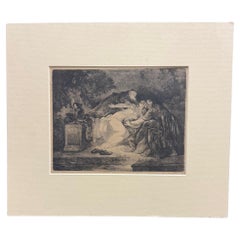Items Similar to Ariadne Abandoned on Naxos by Theseus: Piroli’s Classical Engraving, 1789
Want more images or videos?
Request additional images or videos from the seller
1 of 10
Ariadne Abandoned on Naxos by Theseus: Piroli’s Classical Engraving, 1789
$191.34
£141.50
€160
CA$264.79
A$294.69
CHF 153.42
MX$3,558.71
NOK 1,924.07
SEK 1,817.40
DKK 1,218.67
About the Item
The Abandonment of Ariadne on Naxos by Theseus: A Classical Myth Depicted by Tommaso Piroli, 1789
This captivating copperplate engraving, created by the Italian engraver Tommaso Piroli in 1789, depicts the mythological scene of Ariadne abandoned on the island of Naxos by Theseus. The print comes from Piroli’s celebrated work 'Antichita di Ercolano' (Antiquities of Herculaneum), published in Rome. This monumental publication was dedicated to documenting the remarkable archaeological discoveries from Herculaneum and Pompeii, providing detailed engravings of ancient art and artifacts.
The upper part of the engraving portrays the forlorn figure of Ariadne, reclining on a draped rock formation, gazing sorrowfully at the departing ship of Theseus. The vessel, a classical galley with oars and sails, swiftly leaves the shores of Naxos, emphasizing the finality of her abandonment. The rocky landscape and the distant horizon create a dramatic contrast, reinforcing the emotional depth of the scene. Ariadne's flowing robes and graceful posture are masterfully rendered, capturing both her vulnerability and her regal presence as a princess of Crete.
In the lower section, the engraving features an ornamental frieze depicting goats and a classical urn surrounded by garlands. This decorative element highlights the aesthetic influence of ancient Roman and Greek motifs, often present in the decorative arts of the late 18th century. The balanced composition and symmetry of this lower vignette complement the mythological drama above.
Tommaso Piroli was a distinguished engraver renowned for his precise and elegant technique, working closely with prominent artists and scholars of his time. His illustrations for *Antichita di Ercolano* are invaluable as they provide a glimpse into the artistic heritage uncovered during the excavation of the ancient cities buried by the eruption of Mount Vesuvius in 79 AD. Piroli’s engravings served not only as artistic reproductions but also as scholarly documentation of classical antiquity.
What makes this engraving particularly fascinating is its combination of mythological storytelling and archaeological context. The portrayal of Ariadne reflects the neoclassical fascination with ancient themes, inspired by both literary sources and material culture uncovered at Herculaneum. The engraving technique showcases fine line work, meticulous shading, and an eye for classical proportions, which were hallmarks of Piroli's craftsmanship.
Condition: The print is in good condition, with crisp lines and minimal foxing typical of works from the late 18th century. The paper is well-preserved, retaining a soft, natural patina that enhances its antique charm.
Framing tips: To properly display this piece, consider framing it with an ornate gilt frame or a classical black and gold combination, along with a cream-colored mat that echoes the print’s neoclassical elegance.
- Dimensions:Height: 11.82 in (30 cm)Width: 8.47 in (21.5 cm)Depth: 0.01 in (0.2 mm)
- Materials and Techniques:Paper,Engraved
- Period:1780-1789
- Date of Manufacture:1789
- Condition:Condition: The print is in good condition, with crisp lines and minimal foxing typical of works from the late 18th century. The paper is well-preserved, retaining a soft, natural patina that enhances its antique charm.
- Seller Location:Langweer, NL
- Reference Number:Seller: BG-047531stDibs: LU3054344140362
About the Seller
5.0
Recognized Seller
These prestigious sellers are industry leaders and represent the highest echelon for item quality and design.
Platinum Seller
Premium sellers with a 4.7+ rating and 24-hour response times
Established in 2009
1stDibs seller since 2017
2,587 sales on 1stDibs
Typical response time: <1 hour
- ShippingRetrieving quote...Shipping from: Langweer, Netherlands
- Return Policy
Authenticity Guarantee
In the unlikely event there’s an issue with an item’s authenticity, contact us within 1 year for a full refund. DetailsMoney-Back Guarantee
If your item is not as described, is damaged in transit, or does not arrive, contact us within 7 days for a full refund. Details24-Hour Cancellation
You have a 24-hour grace period in which to reconsider your purchase, with no questions asked.Vetted Professional Sellers
Our world-class sellers must adhere to strict standards for service and quality, maintaining the integrity of our listings.Price-Match Guarantee
If you find that a seller listed the same item for a lower price elsewhere, we’ll match it.Trusted Global Delivery
Our best-in-class carrier network provides specialized shipping options worldwide, including custom delivery.More From This Seller
View AllAntique Engraving of Deucalion and Pyrrha of Phthia, Thessaly, Greece, 1733
Located in Langweer, NL
Antique print titled 'Deucalion & Pyrrha (..)'.
This print depicts Deucalion and Pyrrha. Deucalion, who reigned over the region of Phthia, had been forewarned of the flood by his...
Category
Antique 1730s Prints
Materials
Paper
$306 Sale Price
20% Off
Original Antique Engraving of the Statue of Niobe in Rome, Italy, 1660
Located in Langweer, NL
Antique print, titled: 'Niobe in Hortis Mediceis.' - Statue of Niobe in Rome. In Greek mythology, Niobe was a daughter of Tantalus and Dione.
From the 1660 Dutch edition of 'Icones ...
Category
Antique 1660s Decorative Art
Materials
Paper
$304 Sale Price
25% Off
Antique Print of the Allegory of Time by Picart, circa 1720
Located in Langweer, NL
Antique print titled 'Le Temps qui te passe t'approche du jour auquel tu dois rendre compte du Temps que tu auras passé'. Copper engraving of the Allegory of Time...
Category
Antique Early 18th Century Prints
Materials
Paper
$430 Sale Price
20% Off
Allegory of Surgery Engraving with Etching by B. L. Prevost, 1779
Located in Langweer, NL
Plate : 'Chirurgie, Frontispice.' (Surgery, frontispiece).
This plate shows Hippocrates with a Rod of Asclepius, a naked woman cutting a branch, young children playing, a stork fly...
Category
Antique 1770s Prints
Materials
Paper
$248 Sale Price
20% Off
Free Shipping
Zeus (Jupiter) Engraving from Bertuch – Classical Mythology Print, 1805
Located in Langweer, NL
Zeus (Jupiter) Engraving from Bertuch’s 1805 Porte-Feuille des Enfants – Classical Mythology Print
This finely detailed engraving, published in 1805 as part of Friedrich Justin Bertuch’s Porte-Feuille des Enfants (Children's Portfolio), depicts Zeus, the king of the Greek gods (known as Jupiter in Roman mythology), in a pose that exudes authority and power. Seated on a grand throne with an eagle at his side, Zeus holds a scepter, signifying his dominion over the skies and his role as ruler of the gods.
The print is executed with exceptional precision, capturing the intricate details of Zeus’s muscular form, the folds of his drapery, and the noble posture of the eagle, a symbol of strength and divine power. Subtle hand-tinting adds depth and character to the artwork, enhancing its timeless appeal.
This piece is part of a renowned collection of early 19th-century engravings designed to introduce young readers to the rich world of mythology, art, and antiquity. Its historical and artistic significance makes it a standout addition to any collection of classical prints.
The engraving is rendered with meticulous detail, showcasing the artistry and craftsmanship of the early 19th century. The subtle hand-colored tones enhance the divine aura of Zeus, making this print a timeless addition to any collection of classical antiquities or mythological art.
- Date of Publication: 1805
- Origin: Friedrich Justin Bertuch’s *Porte-Feuille des Enfants*
- Condition: The engraving is in good condition with minor age-related foxing and light discoloration typical of early 19th-century prints. Well-preserved overall.
This print is a perfect choice for collectors, historians, or anyone with an appreciation for classical mythology and 19th-century art.
Here are some recommendations for framing and presenting this engraving to enhance its historical and artistic appeal while ensuring proper preservation:
1. Frame Style
- Material: Choose a high-quality wooden or gilded frame. Options like mahogany, walnut, or an antique gold finish complement the classical theme.
- Design: Select a simple yet elegant frame with subtle decorative details, such as beading or fluted edges, to echo the neoclassical style without overshadowing the engraving.
2. Matting
- Color: Use an acid-free mat in a neutral tone, such as ivory, off-white, or pale cream, to draw attention to the artwork and prevent contact with the glass.
- Border Size: A slightly wider mat border (around 2–4 inches) creates balance and helps focus the viewer's attention on the engraving.
- Double Matting (Optional): For a refined look, consider an inner mat in a soft complementary color like light gray or pale gold to add depth.
3. Glass
- UV-Protective Glass: Opt for museum-grade UV-filtering glass or acrylic to safeguard the engraving from light exposure while reducing glare.
- Non-Glare Option: Non-reflective glass ensures optimal viewing, especially in brightly lit areas.
4. Backboard and Mounting
- Archival Backing: Use an acid-free backing board to protect the engraving from moisture and dust while providing structural support.
- Mounting Method: Secure the engraving with archival-quality corners or hinges to avoid adhesive contact with the artwork.
5. Presentation Placement
- Display the framed engraving in a stable environment with consistent temperature and low humidity to prevent damage. Avoid direct sunlight or exposure to harsh artificial light.
- Suitable spaces include libraries, studies, or galleries where the engraving complements other classical or antique items.
6. Labeling
- Add a small engraved brass plaque or label beneath the frame with details such as "Zeus (Jupiter) – Published in 1805 by Friedrich Justin Bertuch" to highlight its provenance and historical value.
7. Alternative Display
- If not framed traditionally, consider showcasing the engraving in a display case alongside other related prints or artifacts. Use museum-grade lighting to accentuate its details without causing harm.
---
Keywords:
- Zeus engraving...
Category
Antique Early 1800s Prints
Materials
Paper
Print of Water Nymph Clytia, Daughter of Oceanus, Turning into a Sunflower, 1733
Located in Langweer, NL
Antique print titled 'Clytie changée en Tournesol (..)'.
This print depicts Clytia turning into a sunflower. Clytia (or Clytie) was a water nymph, daughter of Oceanus and Tethys ...
Category
Antique 1730s Prints
Materials
Paper
$325 Sale Price
20% Off
You May Also Like
Original Antique Print of The Greek Goddess, Hebe. Dated 1833
Located in St Annes, Lancashire
Wonderful image of Hebe
Fine steel engraving.
Published by Fisher. Dated 1833
Unframed.
Category
Antique 1830s English Neoclassical Prints
Materials
Paper
Original Antique Print After Jan Luyken, Amsterdam, Genesis XXII. 1724
Located in St Annes, Lancashire
Wonderful copper-plate engraving after Jan Luyken
Published by Marten Schagen, Amsterdam. 1724
Text on verso
The measurement given is the paper size.
Category
Antique 1720s Dutch Renaissance Prints
Materials
Paper
Ancient Roman Fresco Herculaneum - Original Etching G. Morghen - 18th Century
Located in Roma, IT
Ancient Roman Scene from the series "Antiquities of Herculaneum", is an original etching on paper realized by Giovanni Morghen in the 18th Century.
Signed in the plate.
Good condit...
Category
Late 18th Century Old Masters Figurative Prints
Materials
Etching
Susanna and the Elders Etching, Jean Pierre Norblin-de la Gourdaine 1776
Located in Stamford, CT
Susanna and the Elders Etching by Jean Pierre Norblin-de la Gourdaine 1776.
The story of Susanna is a short story in the Book of Daniel that tells of a wealthy Babylonian Jewish woma...
Category
Antique Late 18th Century French Prints
Materials
Paper
Original Antique Print after Jan Luyken, Amsterdam, Genesis XIII, 1724
Located in St Annes, Lancashire
Wonderful copper-plate engraving after Jan Luyken
Published by Marten Schagen, Amsterdam. 1724
Text on verso
The measurement given is the paper size.
Category
Antique 1720s Dutch Renaissance Prints
Materials
Paper
Original Antique Print after Jan Luyken, Amsterdam, Genesis II, 1724
Located in St Annes, Lancashire
Wonderful copper-plate engraving after Jan Luyken
Published by Marten Schagen, Amsterdam. 1724
Text on verso
The measurement given is the paper size.
Category
Antique 1720s Dutch Renaissance Prints
Materials
Paper
More Ways To Browse
Antique Brass Chargers
Antique Brass Utensils
Antique Brown Clay Planter
Antique Carved Coconuts
Antique Cast Iron Garden Fountain
Antique Catholic Statues
Antique Chest Of Drawers Ireland
Antique Chinese Eggs
Antique Chinese Headrest
Antique Chocolate Cup
Antique Clocks Philadelphia
Antique Federal Drop Leaf Table
Antique Flip Glass
Antique French Large Urn Porcelain
Antique Galvanized Metal
Antique Heywood Wakefield Chairs
Antique Hudson Bay
Antique Large Green Glass Bottle
